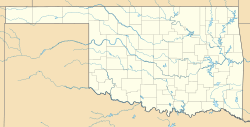White House of the Chickasaws facts for kids
Quick facts for kids |
|
|
White House of the Chickasaws
|
|
| Nearest city | Milburn, Oklahoma |
|---|---|
| Area | 0.1 acres (0.040 ha) |
| Built | 1895 |
| Architect | Waltham, W.A. |
| Architectural style | Queen Anne |
| NRHP reference No. | 71000662 |
| Added to NRHP | August 5, 1971 |
The White House of the Chickasaws is a special historic home located in Milburn, Oklahoma. It was built in 1895 and designed by an architect named W.A. Waltham. The house has a beautiful style called Queen Anne, which was popular back then.
This house is also known as the Gov. Douglas H. Johnston House. That's because Douglas Hancock Johnston, who was a very important leader as the Governor of the Chickasaw Nation, lived there. He and his family lived in the mansion from 1898 until 1971. In 1971, the house was added to the National Register of Historic Places. This is a list of important historical places in the United States.
When the house was first built, it was on the edge of a community called Emet, Oklahoma. Governor Johnston had a store there. Today, its address is 6379 E. Mansion Dr., Milburn, Oklahoma.
Contents
Famous People Connected to the House
Many important people have connections to the White House of the Chickasaws. On July 21, 1902, Johnston Murray was born in the mansion. Johnston Murray later became the 14th Governor of Oklahoma. His father, William H. Murray, was also an Oklahoma Governor. William H. Murray married Mary Alice Hearrell, who was Governor Johnston's niece.
Another interesting person, Julie Chisholm, was also married in the mansion. She was a granddaughter of Jesse Chisholm, a famous trader, and a niece of the Johnston family.
The House Today
Today, the White House of the Chickasaws is a historic house museum. This means it's a museum that looks like a home from a long time ago. The Chickasaw Nation owns the house. They have worked hard to restore it, making it look just like it did around the year 1900.
The house was officially listed on the National Register of Historic Places on August 5, 1971. At that time, it was still owned by the family members of Governor Johnston.
How the House Was Built
The design of the White House of the Chickasaws is called "gingerbread style." This style was very common in Victorian architecture during the late 1800s. It often features fancy, decorative woodwork, like gingerbread on a cookie.
Inside the Main House
The middle part of the house had four main rooms. These rooms were arranged from south to north:
- Parlor room: This was also known as the music room.
- Sitting room: This room was also used as a library.
- State dining room: A formal room for meals.
- Kitchen: Where food was prepared.
Wings and Special Features
Two-room sections, called "wings," were on each side of the main house. The wing on the west side was separated from the sitting room by an open area called a breezeway. This west wing held Governor Johnston's bedroom and his office.
Most of the wood used for building the house came from nearby areas. However, the special wood for finishing touches was brought by wagon from Denison, Texas. The two beautiful fireplaces inside the house had mantles and fronts made of cherry mahogany wood. This special wood came all the way from Chattanooga, Tennessee. The porch that went around the house originally had fancy woodwork made from imported walnut.
Changes Over Time
The White House of the Chickasaws has been kept in very good condition. Only a few changes have been made to its original design. Around 1903 or 1904, the breezeway was removed. A stairway was built in its place, leading to the attic. A bedroom and a bathroom were added in the attic area. Later, more indoor bathrooms were added. The lighting also changed from old-fashioned coal-oil lamps to modern electric lights.
External links
- Chickasaw White House - official site



